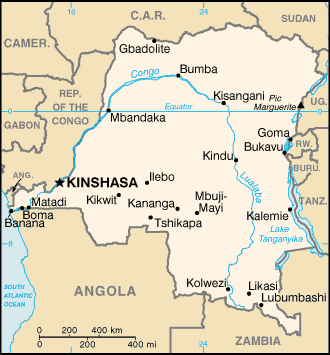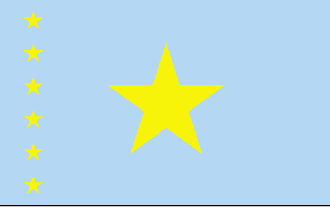
|
Democratic Republic of Congo
Background:
Since 1997, the Democratic Republic of the Congo (formerly called Zaire)
has been rent by ethnic strife and civil war, touched off by a massive inflow
in 1994 of refugees from the fighting in Rwanda and Burundi. The government of
former president Mobutu Sese Seko was toppled by a rebellion led by Laurent
Kabila in May 1997. Kabila was assassinated on 16 January 2001 and his son
Joseph Kabila was named head of state ten days later.
Location:
Location: Central Africa, northeast of Angola.
Area: Total: 2,345,410 sq km, water: 77,810 sq km, land: 2,267,600 sq km.
Area - comparative: Slightly less than one-fourth the size of the US.
Land boundaries: Total: 10,730 km; border countries: Angola 2,511 km (of which
225 km is the boundary of Angola's discontiguous Cabinda Province), Burundi 233
km, Central African Republic 1,577 km, Republic of the Congo 2,410 km, Rwanda
217 km, Sudan 628 km, Tanzania 459 km, Uganda 765 km, Zambia 1,930 km.
Coastline: 37 km.
Climate and Terrain:
Climate: Tropical; hot and humid in equatorial river basin; cooler and drier in
southern highlands; cooler and wetter in eastern highlands.
Terrain: Vast central basin is a low-lying plateau; mountains in east.
Natural resources: Cobalt, copper, cadmium, petroleum, industrial and gem
diamonds, gold, silver, zinc, manganese, tin, germanium, uranium, radium,
bauxite, iron ore, coal, hydropower, timber.
People:
Population: 56,625,039. Ethnic groups: Over 200 African ethnic groups of which
the majority are Bantu.
Religions: Roman Catholic 50%, Protestant 20%, Kimbanguist 10%, Muslim 10%,
other syncretic sects and indigenous beliefs 10%.
Languages: French (official), Lingala (a lingua franca trade language),
Government:
Government type: Dictatorship; presumably undergoing a transition to
representative government.
Capital: Kinshasa.
Independence: 30 June 1960 (from Belgium).
Economy overview:
The economy of the Democratic Republic of the Congo - a
nation endowed with vast potential wealth - has declined drastically since the
mid-1980s. The war, which began in August 1998, has dramatically reduced
national output and government revenue, has increased external debt, and has
resulted in the deaths from war, famine, and disease of perhaps 3.5 million
people. Industries: Mining (diamonds, copper, zinc), mineral processing,
consumer
products (including textiles, footwear, cigarettes, processed foods and
beverages), cement.
Statistics:
Telephones - main lines in use: 20,000.
Telephones - mobile cellular: 15,000.
Radio broadcast stations: AM 3, FM 11, shortwave 2.
Radios: 18.03 million.
Television broadcast stations: 4.
Televisions: 6.478 million.
Internet users: 6,000.
Railways: Total: 4,772 km.
Highways: Total: 157,000 km.
Airports - with paved runways: 24,
with unpaved runways: 205.
Heliports: 1.
Return to Visiting Locations
|

